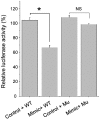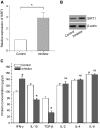Role of miR-124a in T cell activation and immunity in AIDS patients
- PMID: 29201183
- PMCID: PMC5704336
- DOI: 10.3892/etm.2017.5119
Role of miR-124a in T cell activation and immunity in AIDS patients
Abstract
The role of microRNA-124a (miR-124a) in the regulation of T cell activation and immunity in patients with AIDS, was studied to provide new insights for the study, diagnosis, alleviation and treatment of AIDS. RT-qPCR technique was used to quantitatively analyze the expression of miR-124a in peripheral blood CD4+ T cells. Dual-luciferase reporter assay system was established to report possible regulatory relations between miR-124a and its potential target gene SIRT1. RT-qPCR and western blot analysis were used to detect the expression level of mRNA and protein of the target genes in T cells. Normal CD4+ T cells from controls were transfected with miR-124a mimics and its negative control, and miR-124a inhibitor and its negative control were transfected into CD4+ T cells from patients with AIDS by T lymphocyte transfection kit to detect the relative expression level of SIRT1 mRNA and protein. The levels of interferon (IFN)-γ, interleukin (IL)-10, transforming growth factor (TGF)-β, IL-2, IL-4 and IL-6 secreted by T helper cells were detected by enzyme-linked immunosorbent assay (ELISA). miR-124a was upregulated in CD4+ T cells of patients with AIDS. The results of firefly luciferase activity detection showed that miR-124a can directly interact with target gene SIRT1 and negatively regulate its expression. miR-124a mimics/inhibitor transfection experiments showed that overexpression of miR-124a in normal CD4+ T cells significantly reduced SIRT1 expression compared with control group, and the expression of miR-124a was positively correlated with IL-10 and TGF-β expression and negatively correlated with IFN-γ expression, but showed no correlation with other cytokines. In AIDS patients, the inhibition of expression of miR-124a in CD4+ T cells significantly increased the expression of SIRT, at the same time, the expression levels of IL-10 and TGF-β were significantly decreased, while the expression level of IFN-γ was significantly increased and no significant difference was found in the expression of other cytokines. The expression of miR-124a in CD4+ T cells of AIDS patients was upregulated and the Th2 type CD4+ T cells are activated by SIRT1 expression inhibition, which in turn enhance the immunity of HIV-infected cells. Our study provides a new molecular target for the diagnosis, alleviation and treatment of AIDS.
Keywords: AIDS; SIRT1; T cell activation; immunity; miR-124a.
Figures





Similar articles
-
Regulatory effects of miR-138 and RUNX3 on Th1/Th2 balance in peripheral blood of children with cough variant asthma.Zhongguo Dang Dai Er Ke Za Zhi. 2021 Oct 15;23(10):1044-1049. doi: 10.7499/j.issn.1008-8830.2107029. Zhongguo Dang Dai Er Ke Za Zhi. 2021. PMID: 34719421 Free PMC article. Chinese, English.
-
Downregulation of miR-633 activated AKT/mTOR pathway by targeting AKT1 in lupus CD4+ T cells.Lupus. 2019 Apr;28(4):510-519. doi: 10.1177/0961203319829853. Epub 2019 Feb 13. Lupus. 2019. PMID: 30760089
-
miR-124a and miR-155 enhance differentiation of regulatory T cells in patients with neuropathic pain.J Neuroinflammation. 2016 Sep 20;13(1):248. doi: 10.1186/s12974-016-0712-6. J Neuroinflammation. 2016. PMID: 27646435 Free PMC article.
-
Inhibition of microRNA-124a attenuates non-alcoholic fatty liver disease through upregulation of adipose triglyceride lipase and the effect of liraglutide intervention.Hepatol Res. 2019 Jul;49(7):743-757. doi: 10.1111/hepr.13330. Epub 2019 Apr 17. Hepatol Res. 2019. PMID: 30861258
-
Demethylation of MicroRNA-124a Genes Attenuated Proliferation of Rheumatoid Arthritis Derived Fibroblast-Like Synoviocytes and Synthesis of Tumor Necrosis Factor-α.PLoS One. 2016 Nov 8;11(11):e0164207. doi: 10.1371/journal.pone.0164207. eCollection 2016. PLoS One. 2016. PMID: 27824863 Free PMC article.
Cited by
-
MicroRNA-142-3p inhibits IFN-γ production via targeting of RICTOR in Aspergillus fumigatus activated CD4+ T cells.Ann Transl Med. 2019 Nov;7(22):649. doi: 10.21037/atm.2019.10.85. Ann Transl Med. 2019. PMID: 31930050 Free PMC article.
-
Down-Regulation of the Longevity-Associated Protein SIRT1 in Peripheral Blood Mononuclear Cells of Treated HIV Patients.Cells. 2022 Jan 20;11(3):348. doi: 10.3390/cells11030348. Cells. 2022. PMID: 35159154 Free PMC article.
-
Study on the Mechanism of Improving HIV/AIDS Immune Function with Jian Aikang Concentrated Pill Based on Network Pharmacology Combined with Experimental Validation.Drug Des Devel Ther. 2022 Aug 18;16:2731-2753. doi: 10.2147/DDDT.S369832. eCollection 2022. Drug Des Devel Ther. 2022. PMID: 36003311 Free PMC article.
-
Role of lncRNA Xist-miR-124-CCL2 axis in HIV Tat-mediated microglial activation and neuroinflammation.Front Immunol. 2025 May 8;16:1558842. doi: 10.3389/fimmu.2025.1558842. eCollection 2025. Front Immunol. 2025. PMID: 40406114 Free PMC article.
-
MicroRNAs and exosomes: key players in HIV pathogenesis.HIV Med. 2020 Apr;21(4):246-278. doi: 10.1111/hiv.12822. Epub 2019 Nov 22. HIV Med. 2020. PMID: 31756034 Free PMC article. Review.
References
-
- Barré-Sinoussi F, Chermann JC, Rey F, Nugeyre MT, Chamaret S, Gruest J, Dauguet C, Axler-Blin C, Vézinet-Brun F, Rouzioux C, et al. Isolation of a T-lymphotropic retrovirus from a patient at risk for acquired immune deficiency syndrome (AIDS) Science. 1983;220:868–871. doi: 10.1126/science.6189183. - DOI - PubMed
LinkOut - more resources
Full Text Sources
Other Literature Sources
Research Materials
